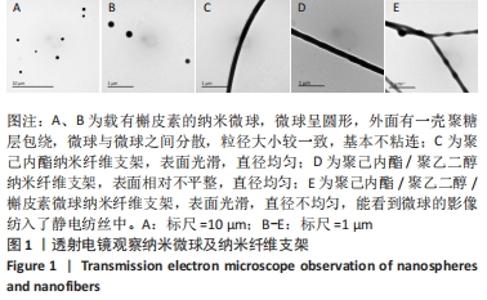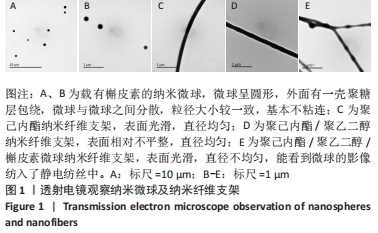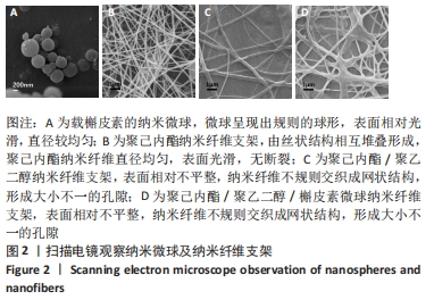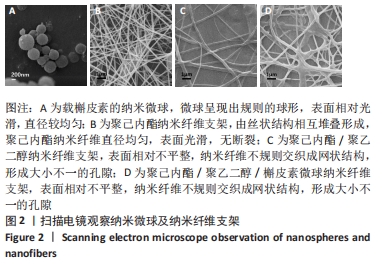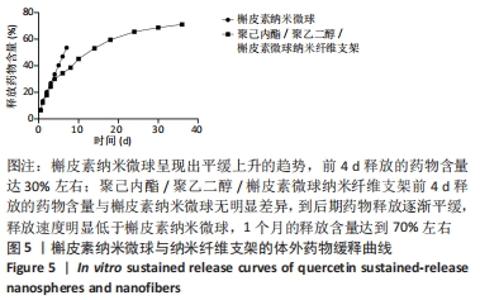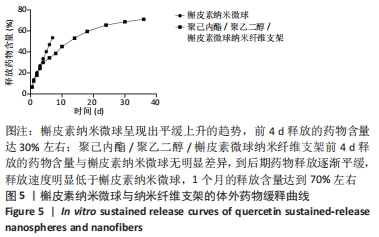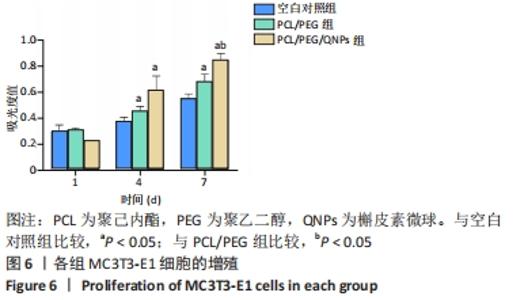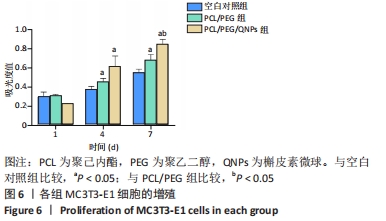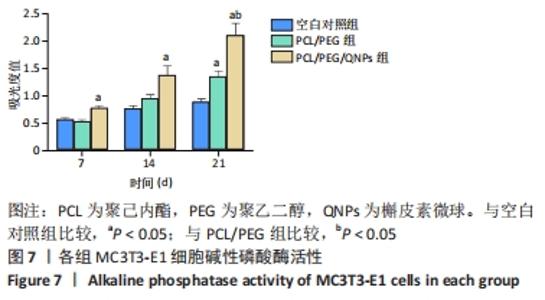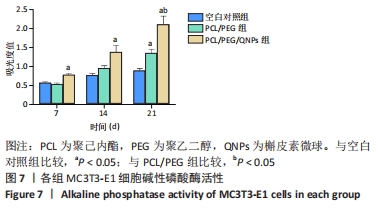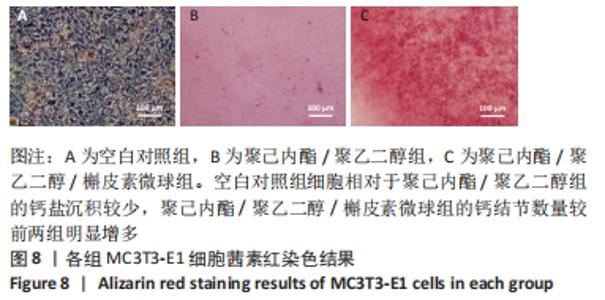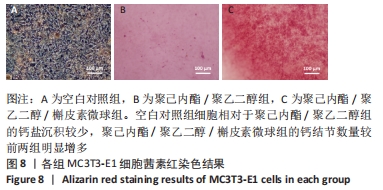Chinese Journal of Tissue Engineering Research ›› 2023, Vol. 27 ›› Issue (12): 1870-1876.doi: 10.12307/2023.017
Previous Articles Next Articles
Effects of quercetin sustained release system on osteogenic properties of MC3T3-E1 cells
Ma Ziyu1, Zhang Bin2, Zhang Yuntao2, Liu Xiaolin1, Bian Zhihong1, Qiao Luhui3, Hou Yudong4
- 1Binzhou Medical College, Binzhou 256600, Shandong Province, China; 2Affiliated Hospital of Binzhou Medical College, Binzhou 256600, Shandong Province, China; 3Yantai Stomatological Hospital, Yantai 264010, Shandong Province, China; 4School of Stomatology, Binzhou Medical College, Yantai 264010, Shandong Province, China
-
Received:2021-11-25Accepted:2022-01-05Online:2023-04-28Published:2022-07-30 -
Contact:Hou Yudong, Master, Professor, School of Stomatology, Binzhou Medical College, Yantai 264010, Shandong Province, China Zhang Bin, Master, Affiliated Hospital of Binzhou Medical College, Binzhou 256600, Shandong Province, China -
About author:Ma Ziyu, Master candidate, Binzhou Medical College, Binzhou 256600, Shandong Province, China
CLC Number:
Cite this article
Ma Ziyu, Zhang Bin, Zhang Yuntao, Liu Xiaolin, Bian Zhihong, Qiao Luhui, Hou Yudong. Effects of quercetin sustained release system on osteogenic properties of MC3T3-E1 cells[J]. Chinese Journal of Tissue Engineering Research, 2023, 27(12): 1870-1876.
share this article
Add to citation manager EndNote|Reference Manager|ProCite|BibTeX|RefWorks
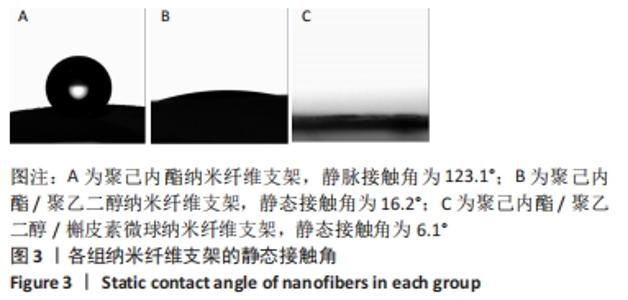
透射电镜观察结果:载有槲皮素的纳米微球呈圆形,外面有一壳聚糖层包绕,微球与微球之间分散,粒径大小较一致,基本不粘连。聚己内酯纳米纤维表面光滑,直径均匀。聚己内酯/聚乙二醇纳米纤维由于聚乙二醇的加入表面相对不平整,直径均匀。聚己内酯/聚乙二醇/槲皮素微球纳米纤维表面光滑,直径不均匀,能看到微球的影像纺入了静电纺丝中。 扫描电镜观察结果:载药纳米微球呈现出规则的球形,表面相对光滑,直径较均匀。聚己内酯纳米纤维支架由丝状结构相互堆叠形成,聚己内酯纳米纤维直径均匀,表面光滑,无断裂。聚己内酯/聚乙二醇和聚己内酯/聚乙二醇/槲皮素微球纳米纤维表面相对不平整,可能是聚乙二醇与微球的加入所导致,纳米纤维不规则交织成网状结构,形成大小不一的孔隙,增加了支架材料的比表面积,且能便于营养物质与代谢产物的进出,为细胞的附着与生存提供了足够的空间和良好的环境。 2.2 纳米纤维支架的静态接触角 见图3。 "
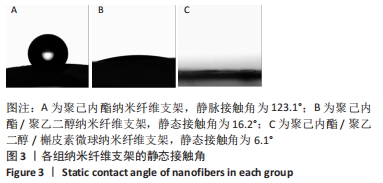

图3为去离子水滴在纳米纤维支架薄膜上2 s后所拍摄的图片,聚己内酯组2 s后的静态接触角为123.1°,聚己内酯/聚乙二醇组2 s后的静态接触角为16.2°,聚己内酯/聚乙二醇/槲皮素微球组2 s后的静态接触角为6.1°。可以看出,聚己内酯/聚乙二醇组的静态接触角相对于聚己内酯组显著减小,说明液滴大部分渗透入纤维材料中,证明聚乙二醇发挥了它的亲水性的优点,显著增加了材料的亲水性能;聚己内酯/聚乙二醇/槲皮素微球组的静态接触角小于聚己内酯/聚乙二醇组,可能微球的加入增大了纤维的粗糙程度或孔隙率,从而进一步改善了材料的亲水性。 2.3 槲皮素标准曲线及回归方程 以无水乙醇溶液作为空白对照组,归零后,测定每种槲皮素乙醇溶液在375 nm处的吸光度值,以Y轴作为吸光度值,X轴作为浓度,绘制标准曲线图,如图4所示,并得出回归方程为:Y=0.067 33×X+0.011 53,R2=0.991 9,表明药物质量浓度在2-12 mg/L之内,呈现良好的线性关系。 "

| [1] 刘相杰,宋科官.生物支架材料及间充质干细胞在骨组织工程中的研究与应用[J].中国组织工程研究,2018,22(10):1618-1624. [2] KONG D, SHI Y, GAO Y, et al. Preparation of BMP-2 loaded MPEG-PCL microspheres and evaluation of their bone repair properties. Biomed Pharmacother. 2020;130:110516. [3] INJAMURI S, RAHAMAN MN, SHEN Y, et al. Relaxin enhances bone regeneration with BMP-2-loaded hydroxyapatite microspheres. J Biomed Mater Res A. 2020;108(5):1231-1242. [4] SONG H, ZHANG Y, ZHANG Z, et al. Hydroxyapatite/NELL-1 Nanoparticles Electrospun Fibers for Osteoinduction in Bone Tissue Engineering Application. Int J Nanomedicine. 2021;16:4321-4332. [5] LAI K, XI Y, DU X, et al. Activation of Nell-1 in BMSC Sheet Promotes Implant Osseointegration Through Regulating Runx2/Osterix Axis. Front Cell Dev Biol. 2020;8:868. [6] HUANG K, CHEN C, CHANG C, et al. The synergistic effects of quercetin- containing 3D-printed mesoporous calcium silicate/calcium sulfate/poly-ε-caprolactone scaffolds for the promotion of osteogenesis in mesenchymal stem cells. J Formos Med Assoc. 2021;120(8):1627-1634. [7] HUANG Y, WANG Z, DENG L, et al. Oral Administration of Quercetin or Its Derivatives Inhibit Bone Loss in Animal Model of Osteoporosis. Oxid Med Cell Longev. 2020;2020:1-21. [8] WONG SK, CHIN K, IMA-NIRWANA S. Quercetin as an Agent for Protecting the Bone: A Review of the Current Evidence. Int J Mol Sci. 2020;21(17): 6448. [9] WANG N, WANG L, YANG J, et al. Quercetin promotes osteogenic differentiation and antioxidant responses of mouse bone mesenchymal stem cells through activation of the AMPK/SIRT1 signaling pathway. Phytother Res. 2021;35(5):2639-2650. [10] ZHANG Q, CHANG B, ZHENG G, et al. Quercetin stimulates osteogenic differentiation of bone marrow stromal cells through miRNA-206/connexin 43 pathway. Am J Transl Res. 2020;12(5):2062-2070. [11] ZHANG W, JIA L, ZHAO B, et al. Quercetin reverses TNFα induced osteogenic damage to human periodontal ligament stem cells by suppressing the NFκB/NLRP3 inflammasome pathway. Int J Mol Med. 2021;47(4):1-11. [12] ANGELLOTTI G, MURGIA D, CAMPISI G, et al. Quercetin-Based Nanocomposites as a Tool to Improve Dental Disease Management. Biomedicines. 2020;8(11):504. [13] ZHOU Y, WU Y, MA W, et al. The effect of quercetin delivery system on osteogenesis and angiogenesis under osteoporotic conditions. Journal of materials chemistry. J Mater Chem B. 2017;5(3):612-625. [14] JÓHANNESSON G, STEFÁNSSON E, LOFTSSON T. Microspheres and nanotechnology for drug delivery. Dev Ophthalmol. 2016;55(3):93-103. [15] DEFRATES K, MARKIEWICZ T, GALLO P, et al. Protein polymer- based nano-particles: Fabrication and medical Applications. Int J Mol Sci. 2018;19(6):1717. [16] CHA C, JEONG JH, KONG H. Poly(ethylene glycol)-poly(lactic- co-glycolic acid) core–shell microspheres with enhanced controllability of drug encapsulation and release rate. J Biomater Sci Polym Ed. 2015; 26(13):828-840. [17] DELDAR Y, ZARGHAMI F, PILEHVAR-SOLTANAHMADI Y, et al. Antioxidant effects of chrysin-loaded electrospun nanofibrous mats on proliferation and stemness preservation of human adipose-derived stem cells. Cell Tissue Bank. 2017;18(4):475-487. [18] SIDDIQUI N, ASAWA S, BIRRU B, et al. PCL-Based Composite Scaffold Matrices for Tissue Engineering Applications. Mol Biotechnol. 2018; 60(7):506-532. [19] ENGEBRETSON B, SIKAVITSAS VI. Long-term in vivo effect of PEG bone tissue engineering scaffolds. J Long Term Eff Med Implants. 2012; 22(3):211. [20] 傅娜,罗晓丁,焦铁军,等.骨组织工程中应用的聚己内酯-聚乙二醇-聚己内酯静电纺丝支架[J].中国组织工程研究,2019,23(22): 3445-3450. [21] 潘璐,程亭亭,徐岚.聚己内酯/聚乙二醇大孔径纳米纤维膜的制备及其在组织工程支架中的应用[J].纺织学报,2020,41(9):167-173. [22] 彭兰兰.静电纺丝法制备PCL/PEG组织工程支架的研究[D].上海:东华大学,2009. [23] LOBO AO, AFEWERKI S, DE PAULA MMM, et al. Electrospun nanofiber blend with improved mechanical and biological performance. Int J Nanomedicine. 2018;13:7891-7903. [24] 王乐,惠敏,董西玲,等.缓释阿托伐他汀钙纳米纤维支架对细胞黏附增殖的影响[J].中国组织工程研究,2020,24(28):4492-4497. [25] BHARATHALA S, KOTARKONDA LK, SINGH VP, et al. In silico and experimental studies of bovine serum albumin-encapsulated carbenoxolone nanoparticles with reduced cytotoxicity. Colloids Surf B Biointerfaces. 2021;202:111670. [26] ARRIAGADA F, GÜNTHER G, ZABALA I, et al. Development andcharacterization offlorfenicol-loaded BSAnanoparticles ascontrolledreleasecarrier. AAPS PharmSciTech. 2019;20(5):202. [27] ZHANG Y, DONG R, PARK Y, et al. Controlled release of NELL-1 protein from chitosan/hydroxyapatite- modified TCP particles. Int J Pharm. 2016;511(1):79-89. [28] GIZAW M, THOMPSON J, FAGLIE A, et al. Electrospun Fibers as a Dressing Material for Drug and Biological Agent Delivery in Wound Healing Applications. Bioengineering. 2018;5(1):9. [29] LEONÉS A, MUJICA-GARCIA A, ARRIETA MP, et al. Organic and Inorganic PCL-Based Electrospun Fibers. Polymers. 2020;12(6):1325. [30] PAGANGA G, RICE-EVANS CA. The identification of flavonoids as glycosides in human plasma. FEBS Lett. 1997;401(1):78-82. [31] 周宇宁.中药槲皮素应用于骨缺损修复的初步研究[D].上海:上海交通大学,2016:75. [32] WONG RWK, RABIE ABM. Effect of quercetin on preosteoblasts and bone defects. Open Orthop J. 2008;2(1):27-32. [33] LI B, YOSHII T, HAFEMAN AE, et al. The effects of rhBMP-2 released from biodegradable polyurethane/microsphere composite scaffolds on new bone formation in rat femora. Biomaterials. 2009;30(35):6768-6779. [34] 关德强,于波,李欣,等.中药促进骨再生的研究进展[J].时珍国医国药,2018,29(4):956-958. [35] 陈述祥,康乐.中药促成骨细胞增殖和分化的机制与作用[J].中国组织工程研究,2012,16(7):1299-1302. [36] 潘慧欣,崔元璐.中药诱导骨髓间充质干细胞成软骨及成骨分化的研究进展[J].天津中医药,2018,35(10):794-797. [37] WANG XC, ZHAO NJ, GUO C, et al. Quercetin reversed lipopolysaccharide-induced inhibition of osteoblast differentiation through the mitogenactivated protein kinase pathway in MC3T3-E1 cells. Mol Med Rep. 2014;10(6):3320-3326. [38] PANG X, CONG Y, BAO N, et al. Quercetin Stimulates Bone Marrow Mesenchymal Stem Cell Differentiation through an Estrogen Receptor-Mediated Pathway. Biomed Res Int. 2018;2018:1-11. [39] WEI J, ZHANG X, LI Y, et al. Novel application of bergapten and quercetin with anti-bacterial, osteogenesis-potentiating, and anti-inflammation tri-effects. Acta Biochim Biophys Sin. 2021;53(6):683-696. [40] ZENG Y, NIKITKOVA A, ABDELSALAM H, et al. Activity of quercetin and kaemferol against Streptococcus mutans biofilm. Arch Oral Biol. 2019; 98:9-16. |
| [1] | Liu Xiaolin, Mu Xinyue, Ma Ziyu, Liu Shutai, Wang Wenlong, Han Xiaoqian, Dong Zhiheng. Effect of hydrogel-loaded simvastatin microspheres on osteoblast proliferation and differentiation [J]. Chinese Journal of Tissue Engineering Research, 2023, 27(7): 998-1003. |
| [2] | Gao Ting, Ma Xiaohong, Li Xiaorong. Extraction and identification of exosomes from three different sources of ovarian granulosa cells [J]. Chinese Journal of Tissue Engineering Research, 2023, 27(6): 860-865. |
| [3] | Tian Qinyu, Tian Xinggui, Tian Zhuang, Sui Xiang, Liu Shuyun, Lu Xiaobo, Guo Quanyi. Protection of manganese oxide nanoparticles for bone marrow mesenchymal stem cell spreading against oxidative stress [J]. Chinese Journal of Tissue Engineering Research, 2023, 27(6): 821-826. |
| [4] | Li Rui, Liu Zhen, Guo Zige, Lu Ruijie, Wang Chen. Aspirin-loaded chitosan nanoparticles and polydopamine modified titanium sheets improve osteogenic differentiation [J]. Chinese Journal of Tissue Engineering Research, 2023, 27(3): 374-379. |
| [5] | Li Yue, Lyu Yan, Feng Wanying, Song Yang, Yan Yu, Guan Yongge. Preparation of hyperoside nanoparticles to repair endometrial injury [J]. Chinese Journal of Tissue Engineering Research, 2023, 27(3): 360-366. |
| [6] | Li Zhen, Liu Hongbao. Influencing factors and mechanism of nanoparticle renal targeting [J]. Chinese Journal of Tissue Engineering Research, 2023, 27(3): 453-460. |
| [7] | Peng Kun. Properties of force growth factor E peptide bionic bone matrix with polyethylene glycol derivative hydrogel as a carrier [J]. Chinese Journal of Tissue Engineering Research, 2023, 27(12): 1811-1816. |
| [8] | Ye Xuwen, Gu Yong, Chen Liang. Curcumin loaded injectable microspheres retard progression of intervertebral disc degeneration [J]. Chinese Journal of Tissue Engineering Research, 2023, 27(12): 1884-1891. |
| [9] | Hu Jinlong, Quan Huahong, Wang Jingcheng, Zhang Pei, Zhang Jiale, Chen Pengtao, Liang Yuan. Effect of copper sulfide nanoparticles loaded thermosensitive hydrogel Pluronic F127 on infected wound healing in rats [J]. Chinese Journal of Tissue Engineering Research, 2023, 27(12): 1927-1931. |
| [10] | Gan Tian, Wang Wenyuan, Yan Shujin, Hao Lan, Ran Haitao, Wang Zhigang, Xia Jizhu. Near infrared photoresponsive nanoparticles loaded with LXR agonists for photothermal immunotherapy [J]. Chinese Journal of Tissue Engineering Research, 2023, 27(12): 1863-1869. |
| [11] | Li Zhiyi, He Pengcheng, Bian Tianyue, Xiao Yuxia, Gao Lu, Liu Huasheng. Bibliometric and visualized analysis of ferroptosis mechanism research [J]. Chinese Journal of Tissue Engineering Research, 2022, 26(8): 1202-1209. |
| [12] | Gao Cangjian, Yang Zhen, Liu Shuyun, Li Hao, Fu Liwei, Zhao Tianyuan, Chen Wei, Liao Zhiyao, Li Pinxue, Sui Xiang, Guo Quanyi. Electrospinning for rotator cuff repair [J]. Chinese Journal of Tissue Engineering Research, 2022, 26(4): 637-642. |
| [13] | Cao Fei, Hui Min, Dong Xiling, Wang Le, Wang Zuxu, Zhang Min, Zhang Xiaoming, Liu Tongbin. Preparation of silver-loaded nanohydroxyapatite/polycaprolactone composite nanofiber scaffold and its osteogenic and antibacterial properties [J]. Chinese Journal of Tissue Engineering Research, 2022, 26(34): 5461-5467. |
| [14] | Lin Lingqi, Chen Jin, Qian Kun, Zhao Liang, Shi Yijie. Preparation and in vitro release of manganese-based metal-organic framework materials loaded with baicalin [J]. Chinese Journal of Tissue Engineering Research, 2022, 26(34): 5475-5481. |
| [15] | Wang Xiao, Liu Qing, Hu Yaorui, Gu Chengxu, Guo Qixuan, Zhu Yonglin, Zhang Luping. Preparation of wogonoside polycaprolactone-polyethylene glycol micelles delivered by adipose stem cells [J]. Chinese Journal of Tissue Engineering Research, 2022, 26(31): 4996-5001. |
| Viewed | ||||||
|
Full text |
|
|||||
|
Abstract |
|
|||||
